Quadriceps Exercises
Medically reviewed by Drugs.com. Last updated on Apr 6, 2025.
What do I need to know about quadriceps exercises?
Quadriceps exercises help reduce knee pain, keep muscles strong and flexible, and improve function after an injury.
What do I need to know about exercise safety?
- Start slowly. These are beginning exercises. Ask your healthcare provider if you need to see a physical therapist for more advanced exercises. As you get stronger, you may be able to do more sets of each exercise or add weights.
- Stop if you feel pain. It is normal to feel some discomfort at first, but you should not feel pain. Regular exercise will help decrease your discomfort over time.
- Warm up before you do quadriceps exercises. Ride a stationary bike or walk for 5 or 10 minutes to warm your muscles.
- Follow the exercise program recommended by your healthcare provider. He or she will tell you which exercises are best for your condition. He or she will also tell you how many repetitions to do and how often you should do the exercises.
Drugs used to treat this and similar conditions
Celebrex
Celebrex is a nonsteroidal anti-inflammatory drug used to treat pain or inflammation. Learn about ...
Mobic
Mobic (meloxicam) is a nonsteroidal anti-inflammatory drug used to treat pain or inflammation ...
Omvoh
Omvoh is used to treat moderate to severe ulcerative colitis or Crohn's disease in adults. This ...
Voltaren Arthritis Pain Gel
Voltaren Arthritis Pain Gel (diclofenac topical) is used to treat joint pain in the hands, wrists ...
Naproxen
Naproxen is a nonsteroidal anti-inflammatory drug used to treat pain or inflammation caused by ...
Ibuprofen
Ibuprofen (Advil, Motrin) treats minor aches and pains caused by the common cold, headaches ...
Celecoxib
Celecoxib is a nonsteroidal anti-inflammatory drug (NSAID) used to treat pain or inflammation ...
Diclofenac
Diclofenac is a nonsteroidal anti-inflammatory drug used to treat pain and inflammation associated ...
Chondroitin/glucosamine
Chondroitin/glucosamine systemic is used for dietary supplementation, osteoarthritis
How do I perform quadriceps stretches safely?
Ask your healthcare provider how often to do these stretches:
- Kneeling hip flexor stretch: Kneel on your left knee. Place your right foot in front of you. Keep your right knee bent and your foot flat on the floor. Your knee should be directly above your ankle. Put both of your hands on top of your right thigh. Keep your back straight and abdominal muscles tight. Put weight on your right leg and lean forward until you feel a stretch in your left thigh. Hold the stretch for about 30 seconds. Repeat 2 or 3 times on each leg or as directed.
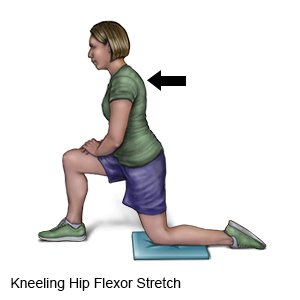
- Standing quadriceps stretch: Stand and place one hand against a wall or hold the back of a chair for balance. With your weight on one leg, bend your other leg and grab your ankle. Bring your heel toward your buttocks. Hold the stretch for 30 to 60 seconds. Switch legs. Repeat 2 or 3 times on each leg.
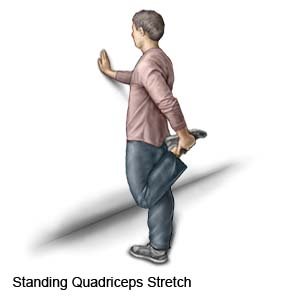
How do I perform quadriceps strengthening exercises safely?
Always stretch before you do strengthening exercises. As you get stronger, your healthcare provider may tell you to you add weights or more repetitions to your strengthening exercises. He or she will tell you how much weight to use.
- Quad set exercise: Lie on a flat, firm surface. Bend your left leg until your foot is flat on the floor. Keep your right leg straight. Tighten the top of your right thigh and hold for 10 to 20 seconds, and then relax. Repeat this exercise 5 to 10 times and then repeat on your other leg.
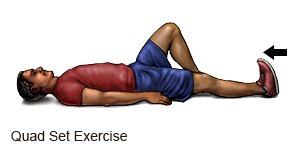
- Straight leg lift: Lie on a flat, firm surface. Bend your left leg until your foot is flat on the floor. Raise your right leg several inches off the floor and hold for 5 to 10 seconds. Lower your leg slowly. Repeat this exercise 5 to 10 times and then repeat on your other leg.
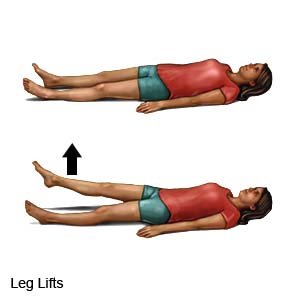
- Sitting leg lifts: Sit in a chair. Slowly straighten and raise one leg. Squeeze your thigh muscles and hold for 5 seconds. Relax and return your foot to the floor. Do 2 sets of 10 lifts on each leg.
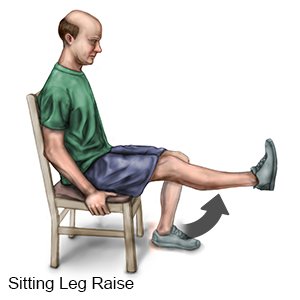
- Standing half squats: Stand with your feet shoulder-width apart. Lean your back against a wall or hold the back of a chair for balance, if needed. Slowly sit down about 10 inches, as if you are going to sit in a chair. Your body weight should be mostly over your heels. Hold the squat for 5 seconds, then rise to a standing position. Repeat 10 times for 1 set. Rest for 1 to 2 minutes. Do another set of 10.
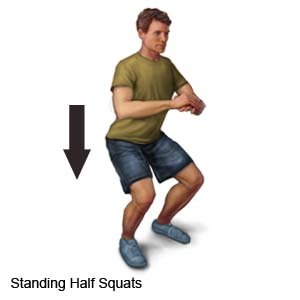
- Step ups: Use a 6-inch stool, step, or other platform to do this exercise. Place one foot on top of the platform. Lift your other foot off the floor and let it hang loosely. Stay in that position for 3 to 5 seconds. Then, slowly lower your foot to the floor. Lower your other foot off the platform surface and onto the floor. Repeat this exercise 5 to 10 times and then repeat on your other leg.

When should I call my doctor?
- Your pain becomes worse or you have new pain.
- You have questions or concerns about your condition, care, or exercise program.
Care Agreement
You have the right to help plan your care. Learn about your health condition and how it may be treated. Discuss treatment options with your healthcare providers to decide what care you want to receive. You always have the right to refuse treatment. The above information is an educational aid only. It is not intended as medical advice for individual conditions or treatments. Talk to your doctor, nurse or pharmacist before following any medical regimen to see if it is safe and effective for you.© Copyright Merative 2025 Information is for End User's use only and may not be sold, redistributed or otherwise used for commercial purposes.
Further information
Always consult your healthcare provider to ensure the information displayed on this page applies to your personal circumstances.
